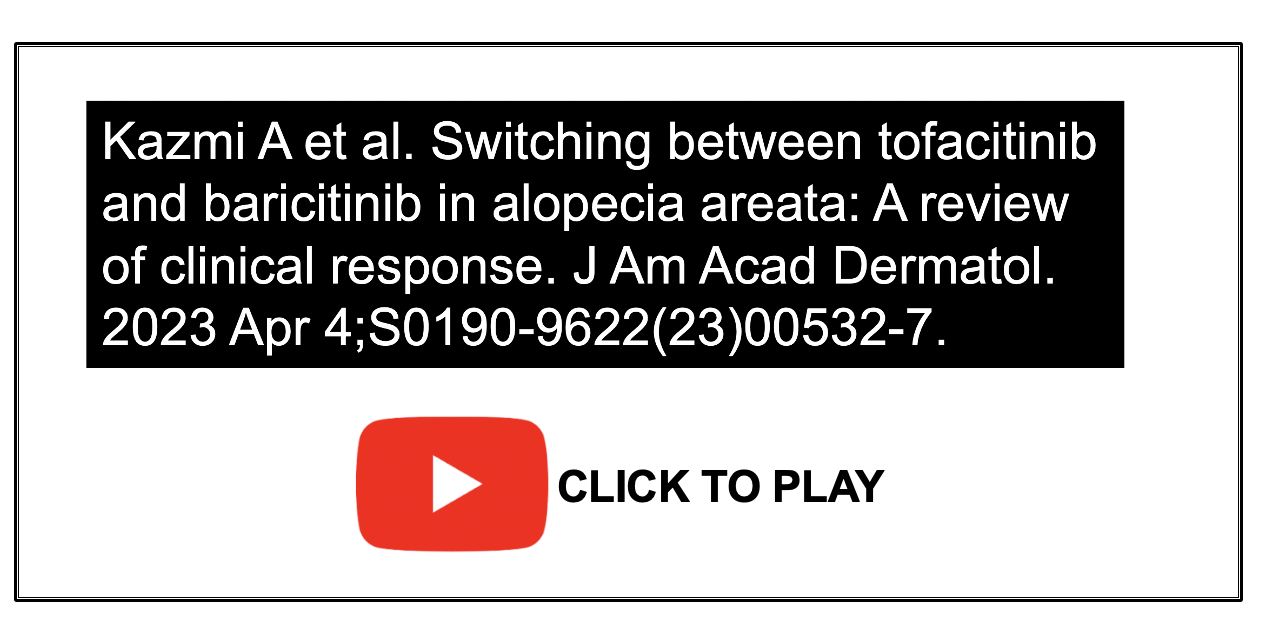Planning to Switch up Your JAK Inhbitor for Alopecia Areata? Patients Requiring a Switch from Tofacitinib to Baricitinib Seem to do Well
Low Chance of Hair Loss Among Patients Requiring a Switch from Tofacitinib to Baricitinib
JAK inhibitors are used to treat more advanced forms of alopecia areata. There are many reasons why a patient with alopecia areata would want to or need to switch from one JAK inhibitor to another JAK inhibitor drug. First, sometimes a certain JAK inhibitor does not seem to help all that much and physicians want to see if using a second different JAK inhibitor instead might work better. Second, sometimes a different JAK inhibitor is covered by insurance and the originally used JAK inhibitor is not – so the patient under pressure to switch if he or she wishes the drug to be paid for by someone else.
Kazmi A et al. 2023
Authors from Australia set out to determine what exactly happens when patients switch JAK inhibitors. This includes patients who were doing quite well on tofacitinib already and switched from tofacitinib to baricitinib. The study also included patients who weren’t doing so well on tofacitinib and switched to baricitinib to see if it could grow more hair.
The authors also had 4 patients who switched from baricitinib to tofacitinib but the numbers are so small it’s hard to make meaningful conclusions so we’ll focus on the tofacitinib to baricitinib switch.
The authors retrospectively reviewed the electronic records of patients with AA between April-2016 and April-2021
All in all the authors found 77 patients (48 male and 29 female) with a mean age of 39 years. 59.7 % had patchy alopecia areata 11.7 % had ophiasis, 13 % had alopecia totalis and 13 % had universalis. The mean baseline SALT score was 53.9. There were 73 patients that were first treated with tofacitinib. 30 of these patients had complete regrowth and 35 had partial regrowth and 8 had no response.
Among the 30 patients with complete regrowth on tofacitinib, 16 of these patients were switched to baricitinib and 100 % maintained their complete remission. 9 of the complete responders on tofacitinib ultimately had a relapse and were switched over to baricitinib. 5 of these 9 patients (55.6%) experienced full regrowth on the new baricitinib and 4 had only partial regrowth with the new drug.
There were 35 patients with only partial response to tofacitinib. 10 of these patients (28.6%) had a complete regrowth upon switching to baricitinib.
There were 8 patients who did not grow hair on tofacitinib therapy. None of these 8 patients had full regrowth when they switched to baricitinib although 2 had partial regrowth.
Conclusion
I liked this study. This is much needed data that we have all been waiting for. These data suggest that switching from tofacitinib to baricitinib is likely to lead to similar results and possibly better results compared to what one had on tofacitinib. Complete responders on tofacitinib seem to maintain hair on baricitinib. This is important because this data suggests that most patients who need to switch from tofacitinib to baricitinib (for insurance coverage etc) are likely to do great and continue to grow hair really well.
Patents who were partially responding on tofacitinib are likely to either partially respond again on baricitinib or in 30 % of the time - possibly even completely regrow hair fully.
REFERENCE
Kazmi A et al. Switching between tofacitinib and baricitinib in alopecia areata: A review of clinical response. J Am Acad Dermatol. 2023 Apr 4;S0190-9622(23)00532-7.
This article was written by Dr. Jeff Donovan, a Canadian and US board certified dermatologist specializing exclusively in hair loss.

